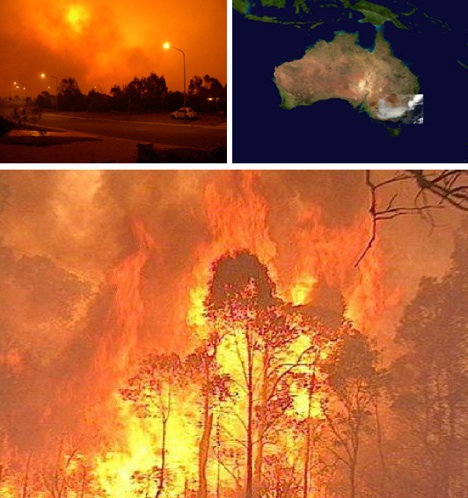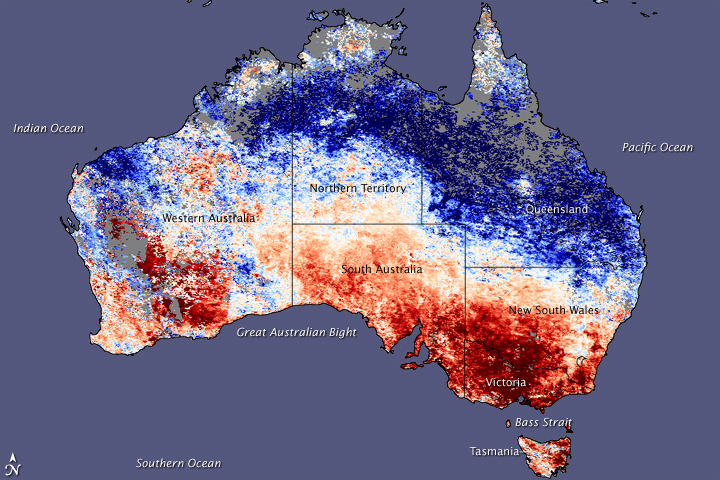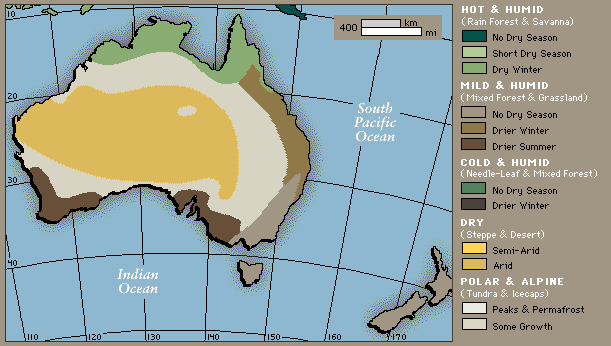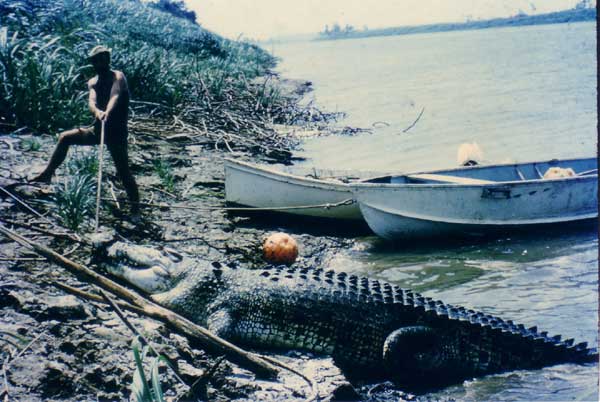![]()
Australia: Sequías, Olas de Calor, Incendios Forestales, Inundaciones y Cocodrilos
Decimos en España que “nunca llueve a gusto de todos”, así como que a “perro flaco todo son pulgas”. Pues bien, los australianos están viviendo una gran pesadilla ambiental a la que se le unen los serios efectos de la crisis económica. Ninguna de las noticias que vamos a ofrecer hoy es nueva, por sorprendente que parezca. Sin embargo, la magnitud de algunas y la confluencia de todas ya resulta ser tan usual. Se trata del continente más árido del planeta. Pero a ello se le suma la sequía más aguda que ofrecen los registros históricos, una tremenda ola de calor que afecta al sur e inundaciones en el norte, con el añadido de los cocodrilos campando a sus anchas por algunas localidades y que parece probable que ya hayan dado cuenta de una pobre criatura de cinco años. Eso sí, bajo los pavorosos incendios que azotan a los ambientes meridionales (y que ya han causado más de 189 víctimas humanas, 400.000 hectáreas, 20.000 afectados y miles de casas calcinadas actualizado a día 17 de febrro de 2009), subyacen algunos al parecer ocasionados por pirómanos y otros por negligencia (sumando un 40 por ciento de los focos, según las autoridades). Las grandes extensiones desérticas y semidesérticas parecen haber quedado tórridamente a salvo. Hoy, 9 de febrero de 2009, el boletín de noticias Terradaily se encontraba repleto de notas que daban cuenta de estos sucesos, así como de la grave sequía que sufre también China (a penas recuperada de inundaciones previas y el gran terremoto del año pasado). En fin, toda una calamidad que afectan a nuestros “vecinos” de las antípodas. Reiteramos que nada es nuevo pero……….

Incendios en Australia Fuente: Ecoist
La sequía está siendo de lo más aguda y prolongada de la historia de este país Esta se encuentra afectando a la zona con mayor potencial agrícola, por lo que la producción de alimentos se encuentra seriamente afectada, lo cual agudiza la crisis económica que castiga nuestra sociedad globalizada. La sequía, junto a la ola de calor y, como no el viento, ha dado lugar a la aparición de grandes incendios que han afectado ya a más de 400.000 hectáreas del país, calcinando algunas zonas urbanas completamente. A día de hoy ya se han contabilizado más de cien víctimas humanas. Sin embargo las cifras ascenderán, según las autoridades.

Australia: Zona Afectada por la sequía y hola de calor. Fuente: NASA
Por su parte, no es inusual que en algunas zonas las inundaciones vengan acompañadas de la visita de los cocodrilos, que así campan a sus anchas por algunas urbes. Al parecer existen evidencias de que un niño puede haber sido víctima de estos turistas indeseados. La verdad es que los ciudadanos australianos deben estar más que preocupados, aterrados, con tanta calamidad. Esperemos que este vendaval de desastres acabe lo antes posible. Sería largo, aunque muy interesante, analizar varios de estos problemas por separado. Por ejemplo, el de los efectos de la sequía en la agricultura, ya que algo ha tenido que ver la planificación territorial. Ahora bien, no seremos los españoles y menos en estos momentos, los que podamos dar lecciones en la materia. En este post tan solo os doy cuenta de las noticias que reproduzco debajo de Terradaily.

Mapa bioclimático de Australia: Fuente. Encarta
Como comentarios finales tan solo añadir que el sur de Australia “disfruta” de una zona de clima mediterráneo (marrón negro al sur). También se presenta una lista de desastres previos, muchos de los cuales se dan en el verano austral, es decir durante estos meses. Muchos de vosotros también habréis oído varias veces el efecto de devastadores incendios en California, otra de las cinco regiones mediterráneas del mundo. En todos estos casos, a la incidencia “natural” de los incendios, cabe añadir la presencia de pirómanos y de negligencias de los ciudadanos. Lamentablemente no somos los únicos que sufrimos a enfermos mentales y estúpidos. Tengo menos noticias de tales desastres de las otras dos zonas mediterráneas del hemisferio sur, a saber parte de Chile y Sudáfrica. Espero y deseo que no sea por mi desinformación, sino por la ausencia de noticias al respecto.
Juan José Ibáñez

Cocodrilos llegan a algunas ciudades tras inundaciones. Fuente: Amazing Australia
Death Stalks Australia As Fire And Heat Kill Hundreds
by Staff Writers;
The death toll from the worst wildfires in
Police and a spokesman for the Department of Sustainability and Environment in
Thousands of survivors jammed community halls, schools and other makeshift accommodation as troops and firefighters battled to control huge blazes fed by tinder-box conditions after a once-in-a-century heatwave. The devastating fires have affected around 3,000 square kilometres (1,200 square miles) — an area larger than
The death toll has far surpassed the 75 killed in wildfires in
The latest fires in Australia’s southeast flared on Saturday, fanned by high winds after a heatwave sent temperatures soaring to 46 degrees Celsius (115 Fahrenheit), and continued to burn out of control Sunday. They wiped out the pretty resort
«He had skin hanging off him everywhere and his little girl was burnt, but not as badly as her dad, and he just came down and he said ‘Look, I’ve lost my wife, I’ve lost my other kid, I just need you to save (my daughter)’.»
An AFP photographer who made it into Kinglake described a road strewn with wrecked cars telling of desperate, failed attempts to escape. The cars appeared to have crashed into each other or into trees as towering flames put an end to their desperate flight from the town. Some did not even make it onto the road, said Victoria Harvey, a resident waiting at a roadblock to be allowed to return to the site of her destroyed home. She told reporters of a local businessman who lost two of his children as the family tried to flee. «He apparently went to put his kids in the car, put them in, turned around to go grab something from the house, then his car was on fire with his kids in it and they burnt,» she said.
In Kinglake, scores of homes were levelled along with shops and the school. The smouldering ruins of the town were deserted except for police and forensic experts. Police Deputy Commissioner Kieran Walshe said there was no doubt that arsonists were behind some of the fires. «Some of these fires have started in localities that could only be by hand, it could not be natural causes,» he said. Police have warned that arsonists could face murder charges.
Meanwhile, in Queensland, in the northeast of the country, where some towns have been inundated for a week by cyclonic rains, two people were missing after their car was swept away — and a crocodile is believed to have taken a boy. «The boy was walking with his seven-year-old brother earlier this morning when he followed his dog into floodwaters,» police said in a statement. «He disappeared in the water and his brother saw a large crocodile in the vicinity of his disappearance.»
Much of the state has been declared a disaster zone, with an area of more than a million square kilometres (386,100 square miles) and 3,000 homes affected by floods.
Major Australian bushfire disasters
1.
2.
3.
4.
5.
6. January, 1994: Four dead, 200 homes destroyed when fires hit
7.
8.
9.
10. Jan 14-
11.
12.
13. February-March, 1922: 60 dead in Gippsland, eastern
Survivors tell of Australian bushfire horror
by Staff Writers; Kinglake (AFP)
Survivors of
Residents in the worst-hit areas northwest of Melbourne, where most the reported 93 fatalities occurred, told how they lost loved ones to the flames and desperately tried to help the injured, including children. Entire townships were razed to the ground, with burnt-out cars strewn across the road outside one of the worst-hit communities, Kinglake, standing in mute testimony to residents who made doomed attempts to escape. An AFP photographer who reached the town described how the cars had crashed into each other or into trees as towering flames put an end to their flight from the town.
Nearby, the once picturesque hamlet of Marysville was reduced to smoking ruins. «Marysville, which was one the loveliest townships in
Chris Harvey, who has lived in the town for 22 years and lost his home, believed authorities were trying to shield locals from the horrors awaiting them. «There’s a five-car pile-up on the road into town, all the cars are burnt,»
Witnesses told of trees «exploding» with the intensity of the heat and recounted fire fronts that raced towards them with terrifying speed. Strathewen resident Mary Avola escaped the flames but her husband of 43 years, Peter, died after they fled their home in separate cars trying to reach a nearby sporting oval. «He was behind me for a while and we tried to reach the oval but the gates were locked,» Avola told
«He just told me to go and that’s the last time I saw him.» Authorities have found his body. Marie Jones said she was staying at a friend’s house in Kinglake when a badly burnt man arrived with his infant daughter, saying his wife and other child had been killed. «He was so badly burnt,» she told the Melbourne Age’s website.
«He had skin hanging off him everywhere and his little girl was burnt, but not as badly as her dad, and he just came down and he said ‘Look, I’ve lost my wife, I’ve lost my other kid, I just need you to save (my daughter).'» Callers to national radio described how they were huddling in swimming pools as flames approached their homes, and of how children were terrified by the powerful winds, furnace-like heat and an eerie orange glow dominating the sky. «It was so scary, my little girl, she’s five years of age and… she’s emotionally traumatised by what’s happened today — the horrible orange glow,» said a caller who identified himself as Roger from Traralgon South.
Jay Cherie described her family’s nightmare drive from Kinglake to safety though a raging inferno. «When the power went out I madly started to try and pack some things. My husband came running into the house and said, ‘grab the kids, grab the cat, we’ve got to get out’,» she said.In the car «we had fire coming in on the right-hand side of us on a paddock and we had houses to the left of us on fire. «My little girl was saying to me, ‘Mum am I going to see my friends again?’, she also said to me, ‘Mum am I going to live tomorrow?'»
Australian wildfire arsonists face murder charges: police
by Staff Writers; Sydney (AFP)
Arsonists responsible for starting Australian wildfires which killed at least 84 people and destroyed more than 600 homes could be charged with murder, police warned Sunday. There was no doubt arsonists were behind some of the fires in Australia’s southeast, police said, shocking a nation watching transfixed as towering flames and grieving families dominated television screens.
«Some of these fires have started in localities that could only be by hand, it could not be natural causes,» Victoria state Police Deputy Commissioner Kieran Walshe said.»We do need to get to the position where we can get our investigators and our forensic scientists into the fire scenes to do a full, thorough investigation,» he said.
A police spokeswoman said anyone found to have started the fires — during a once-in-a-century heatwave which has turned the countryside into a tinderbox — would likely be charged with murder or manslaughter. «They can be charged with murder, it depends on the evidence that comes to hand,» the spokeswoman said. «They could be charged with manslaughter or they could be charged with murder.»
The government’s Australian Institute of Criminology released a report last week which said half of the nation’s 20,000 to 30,000 bushfires each year are deliberate. Twenty-six fires were burning in Victoria Sunday, with another 53 blazing throughout neighbouring New South Wales.
Police in New South Wales said they had charged a 31-year-old man with deliberately lighting a fire Saturday at Peats Ridge, north of the capital Sydney, which burnt 175 hectares (430 acres). State premier Nathan Rees said arsonists faced a maximum 25 years’ jail. «We will throw the book at you if you are caught,» he said. «This is not fun, this is not clever, this is something that can kill people.» South Australia Premier Mike Rann said at least 20 percent of fires in the state this summer had been set by arsonists, with another 20 percent the result of «stupidity or negligence.»
«These people are terrorists within our nation, they are the enemy within and we have to be increasingly vigilant about them,» he told reporters.
Boy feared snatched by crocodile in Australian floodwaters
by Staff Writers; Sydney (AFP)
A five-year-old boy is feared to have been snatched by a crocodile in floodwaters in northern
«He disappeared in the water and his brother saw a large crocodile in the vicinity of his disappearance.». A large-scale search for the boy has been launched at
Much of the state has been declared a disaster zone, with an area of more than a million square kilometres (386,100 square miles) and 3,000 homes affected by floods due to torrential rains.
Hundreds of people were forced to evacuate and others have been stranded in their homes. Rain continued to fall on the saturated state on Sunday, easing in the worst-hit north but threatening to flood areas that have so far escaped the monsoonal downpours. «Tomorrow, the monsoon trough continues its movements south and the bulk of the rain will head down towards Rockhampton,» a weather bureau spokesman said.
«We can expect local flooding to occur as that rain moves south.» While the north of eastern
